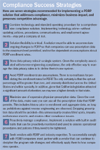Just What the Doctor Ordered
Pharma should comply with PDRP. If the program fails, a likely result is state legislation that proves even more restrictive.
For years, the American Medical Association (AMA) has had a thorn in its side: doctors who are concerned about pharmaceutical sales reps with unrestricted access to their personal prescribing data. It's long been a problem, but finding a solution has been complicated by the fact that many in the healthcare industry, including pharma companies, make appropriate use of physician-level prescribing data—in ways that benefit AMA's very members.
Over the years, the AMA House of Delegates has passed resolutions, and calls for government legislation have been sounded. For example, the California Assembly Bill 262 (AB 262) was designed to regulate the use of physician data for marketing purposes and to protect doctors' privacy by regulating the activities of pharmacists and data vendors. In November 2004, AB 262 was defeated by a very narrow margin.

The latest AMA effort—the Prescribing Data Restriction Program (PDRP), a self-regulatory alternative to state regulation—is said to be its strongest yet. With less than two months left before PDRP goes into effect, the new program looms as one of the most significant business and compliance challenges for pharma since the introduction of the Prescription Drug Marketing Act (PDMA). Already, California has decided against reintroducing AB 262 in favor of the PDRP solution. Pharmaceutical manufacturers need to make the PDRP work, since the alternative, government legislation, is not in anyone's best interest. Without PDRP, long-term access to physician-level data within the healthcare system is called into question.
Since pharma companies use physician-level prescribing data to determine everything from directing promotional activity to measuring results and calculating compensation, the impact of PDRP will be widespread. Most of the program's rules were finalized in August 2005, although it should be expected that changes might occur from time to time. In March 2006, for instance, access to product quantiles (e.g., quintiles and deciles), which position a physician's prescribing volume in a particular fifth or tenth of a rep's territory, were removed from the program rules.
Not everyone in the industry is up to speed on PDRP. For those who currently are working on compliance, for instance, a common strategy is to completely eliminate all individual prescription data from the hands of the first-line manager and sales rep. But upon reviewing PDRP, it can be seen that this is not the only approach that can be adopted to achieve compliance. In fact, it will unnecessarily put an organization at a competitive disadvantage.
We suggest seven critical success factors that can help a company build a successful PDRP strategy (see "Compliance Success Strategies).

Compliance Success Strategies
History
To address responsible and ethical use of individual prescription data by the pharmaceutical industry, the AMA created the Best Practices Guidelines for the Use of Physician-Specific Prescribing Data in 2001. Despite these guidelines, physicians continued to voice concerns over the release of prescribing data, citing their own privacy concerns and condemning some pharmaceutical sales representatives' behavior. To develop the PDRP rules, the AMA conducted physician surveys and met with the industry (AMA database licensees and pharmaceutical manufacturers) to convey physician concern and understand the program's potential ramifications.
Now the AMA is working to allow physicians to enroll in PDRP. Companies who license AMA data will see indicators that identify physician participation and show whose data cannot be included. These indicators must be observed when processing physician data in accordance with the PDRP data disclosure rules.
Vital Facts
Achieving PDRP compliance requires a complete understanding of the program rules. Applying the complex HIPAA-style data-privacy rules that describe how to restrict the use of physician prescribing data is the real challenge behind the program. Here are some key facts about the new program:
- PDRP is effective July 1, 2006.
- PDRP directly affects first-line managers and sales reps, and can indirectly affect other personnel that work with physician-level prescription data, for example, if a company is buying raw data that must be broken out by PDRP enrollees and non-enrollees.
- Releasing a physician's data to a rep or supervisor is prohibited for three years from the date a physician signs up, but the participating physician can lift the restriction at any time. PDRP only affects data after the date of physician enrollment. It does not affect historical data.
- All physician-level prescription data released to sales forces, regardless of update frequency or source, must comply with PDRP. For example, monthly prescription data must comply within 90 days from receipt of the data; quarterly data must be clean within 90 days of the end of the quarter during which a physician enrolls. If the rules don't change, companies will get an enrollment update every quarter.
- Certain products are exempt from PDRP compliance, including those that are dispensed or administered in a physician's office, or which a physician orders directly from the pharmaceutical manufacturer.
Data Disclosure Rules
The PDRP disclosure rules specifically target first-line managers and sales reps, while everyone else in the company maintains full access to the prescribing data as if PDRP did not exist. If the company is receiving data with PDRP recipients flagged, the company must be able to generate PDRP-compliant versions of the information before it is distributed to first-line managers or sales reps.
When physicians enroll in PDRP, the program limits first-line managers or sales reps from viewing their prescription data to the following:
- Reps and direct managers can view the physician's prescribing volume quantiled at the therapeutic class level.
- They can view aggregated data (territory or specialty rollups, for example) or segmented data (categories into which the prescriber falls, such as an early-adopter of drugs, for example) as long as this is not likely to reveal blocked data. Aggregated or segmented data is used to provide messaging and direction in the field by grouping similar physicians using qualitative and quantitative measurements.
- Reps and their direct supervisors are not allowed to access individual doctors' prescription counts, prescription volume, projected prescription volume, prescription dollar volumes, prescription market share, product quantile, prescription percent, or any type of change indicators (e.g., color coding, up/down arrows, and directional indicators, such as alerts).
Paramount to complying with PDRP's disclosure rules: Reverse engineering of blocked data is strictly prohibited. For instance, if a first-line manager or sales representative cross-indexed an incentive compensation report with a physician target report (unless they are both PDRP compliant), it might be possible to determine an individual physician's actual prescribing volume or infer an increase or decrease. Or they might use a territory performance report with a physician target list.
As these examples illustrate, the reverse engineering requirement is difficult to implement without the use of advanced technology.
PDRP requires companies to censor prescription data, as previously described, to observe the physician's desire to have his prescribing data restricted. But it does not require the removal of all physician prescribing data from systems used by first-line managers or sales reps.
Achieving full compliance while using the maximum level of individual prescriber data permitted by PDRP may pose a greater technology challenge than most organizations will have determined.
Organizational Impact
The use of physician prescribing data has become so ingrained within sales and marketing that the impact of PDRP compliance will be widespread. Computer systems, business strategies, standard operating procedures, and policies are all affected.
When assessing readiness, pharmaceutical companies may need to reconsider vast sales-support technologies that integrate prescriber data, including incentive compensation, sales reporting (including dashboards and alerts), ad hoc reporting (especially distribution to first-line managers and sales reps), physician targeting and pull through, sales force automation, customer segmentation indicators, marketing messages, detailing and sampling, standard operating procedures and polices, sales training, contract sales, and human resources.
A compliance strategy that doesn't consider all of these elements is incomplete and may expose a company to potential compliance violations.
Compliance
Pharmaceutical companies should support the AMA and comply with PDRP. If the program fails, the likely result is state legislation that almost certainly will prove more restrictive than PDRP. Clearly, no one wants this outcome. Beyond California, New Hampshire, West Virginia, Arizona, and Hawaii also have recently proposed legislation. At press time, the New Hampshire bill already had passed the House and was pending in the Senate. For now, the other state legislatures are standing down to give PDRP a chance.
The AMA has stated that it will investigate all violations aggressively. If an organization is found in breach of PDRP, the ultimate penalty is AMA license revocation, which may lead to the loss of access to all physician prescription data.
Anyone who wonders what it would be like to operate without physician prescription data might reflect on how business was done in 1989, before physician-level prescribing data was available. Today it would be worse. These days, the prescription influence chain has become much more difficult to understand without access to this type of information.
Playing By the Rules
With the physician sign-up already underway, and the program going into effect on July 1, pharmaceutical companies must be prepared to fully embrace PDRP by quickly establishing and implementing a compliance strategy. PDRP offers the healthcare industry an excellent alternative to government legislation regarding the use of physician prescribing data.
Companies should expect to pay a premium for solutions that are designed optimally for PDRP compliance. To rationalize the cost, the pharmaceutical industry should measure it against the potential revenue losses caused by non-compliance.
Jim Alonso is chairman and chief executive officer at ASI Business Solutions, Inc. David Menzies is ASI's vice president, global technology services.
Addressing Disparities in Psoriasis Trials: Takeda's Strategies for Inclusivity in Clinical Research
April 14th 2025LaShell Robinson, Head of Global Feasibility and Trial Equity at Takeda, speaks about the company's strategies to engage patients in underrepresented populations in its phase III psoriasis trials.
Beyond the Prescription: Pharma's Role in Digital Health Conversations
April 1st 2025Join us for an insightful conversation with Jennifer Harakal, Head of Regulatory Affairs at Canopy Life Sciences, as we unpack the evolving intersection of social media and healthcare decisions. Discover how pharmaceutical companies can navigate regulatory challenges while meaningfully engaging with consumers in digital spaces. Jennifer shares expert strategies for responsible marketing, working with influencers, and creating educational content that bridges the gap between patients and healthcare providers. A must-listen for pharma marketers looking to build trust and compliance in today's social media landscape.
